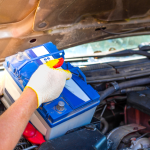Finding yourself in a situation where your vehicle is submerged in water can be one of the most frightening experiences imaginable. Panic can quickly set in, making it difficult to think clearly and take the necessary actions to ensure your safety. However, knowing what to do in such a scenario can significantly increase your chances of escaping unscathed. In this article, we’ll provide you with four essential tips to help you survive when your vehicle is going underwater.
Whether you’re navigating through flood-prone areas, driving near lakes or rivers, or just want to be prepared for the unexpected, these friendly and practical strategies can empower you to act decisively when it matters most. So buckle up and let’s dive into these life-saving tips!
Table of Contents
- Understanding the Immediate Danger When Your Vehicle is Submerged
- Essential Actions to Take Before Your Vehicle Fully Sinks
- Techniques for Escaping a Sinking Vehicle Safely
- Post-Escape Considerations and Emergency Resources to Use
- Q&A
- Closing Remarks
Understanding the Immediate Danger When Your Vehicle is Submerged
When your vehicle is submerged in water, the immediate danger is not just the risk of drowning, but also the potential for panic to sabotage your escape. The moment your car begins to fill, it can feel overwhelming, but maintaining a clear mind is crucial. Your first instinct may be to open the door, but the water pressure will often make this impossible until the vehicle is almost fully submerged. Instead, focus on a few key actions: stay calm, assess your surroundings, and prepare for your exit. Remember, the longer you wait, the more difficult your escape will become as the car fills with water.
To increase your chances of escaping safely, consider these essential steps:
- Unbuckle your seatbelt: This will give you the freedom to move and prepare for escape.
- Open a window: If the water hasn’t risen too high, rolling down a window can provide a quick exit point.
- Wait until the vehicle is submerged: This equalizes the pressure, making it easier to open the door.
- Swim to safety: Once out, swim towards the surface and away from the vehicle.
Essential Actions to Take Before Your Vehicle Fully Sinks
When faced with the terrifying prospect of your vehicle sinking underwater, it’s crucial to act swiftly but calmly. Start by unbuckling your seatbelt immediately to free yourself for a quick escape. Next, you should roll down your windows as soon as possible; this will allow water to enter the vehicle and equalize pressure, making it easier to open the door later. If the power windows are unresponsive, use a window-breaking tool to shatter the glass. The key here is to ensure a clear exit route before the situation worsens.
As time is of the essence, focus on taking deep breaths to manage your panic and maintain clarity. If the water is rising rapidly, consider climbing to the back seat or the highest point of the vehicle for a moment, as this will buy you some time while you figure out your escape. Remember to stay calm and prioritize your actions effectively. Engaging in a few survival techniques can make all the difference:
| Action | Purpose |
|---|---|
| Unbuckle seatbelt | Free yourself for escape |
| Roll down windows | Equalize pressure |
| Take deep breaths | Reduce panic |
| Climb to the back seat | Gain time and height |
Techniques for Escaping a Sinking Vehicle Safely
When you find yourself in a sinking vehicle, the first step is to remain calm and focused. Panic can lead to poor decision-making, so take a deep breath and remember these key actions. Start by unbuckling your seatbelt, as this is your first opportunity to escape. If you have passengers, ensure they do the same. Next, roll down the windows if the water level permits—this can help equalize pressure and make it easier to exit. It’s best to prepare for this action before any emergency occurs, as electric windows may fail shortly after submersion.
If the windows cannot be opened in time, use a sturdy object to break the glass, targeting the corners for maximum effectiveness. Once the escape route is clear, prioritize getting out of the vehicle as quickly as possible. Remember to swim away from the vehicle’s path; the current may push you toward it, increasing your risk of being trapped. In case you’re unable to escape through the windows, taking a deep breath and awaiting the moment the vehicle is fully submerged can give you a better chance to exit through the door when the pressure equalizes. Here are some essential points to keep in mind:
- Stay calm to make rational decisions.
- Unbuckle seatbelts immediately, including those of passengers.
- Roll down windows if possible before submersion.
- Use a tool to break glass if windows won’t open.
- Swim away from the vehicle and avoid getting caught in currents.
Read More: Tips to Make your Car Smell Like 5-star Hotel
Post-Escape Considerations and Emergency Resources to Use
After successfully escaping from a sinking vehicle, it’s crucial to prioritize your safety and seek help. Immediately assess your surroundings for hazards, such as oncoming traffic, sharp debris, or strong currents. Once you are in a safe position, consider reaching out for assistance. Keeping a few essential emergency resources handy can significantly enhance your chances of survival:
- Emergency App: Download a reliable emergency app that can quickly connect you to local emergency services.
- First Aid Kit: Ensure you have a basic first aid kit in your vehicle to address any injuries.
- Flashlight: A waterproof flashlight can help you signal for help or navigate in low light conditions.
- Whistle: Use a whistle to attract attention without expending too much energy.
It’s also important to stay informed about local emergency resources that can assist you in a crisis. Familiarizing yourself with nearby facilities and their contact information can make a significant difference in stressful situations. Below is a simple table listing essential resources you might consider:
| Resource | Contact Information | Service |
|---|---|---|
| Local Fire Department | (555) 123-4567 | Rescue Services |
| Emergency Medical Services | (555) 234-5678 | Medical Assistance |
| Roadside Assistance | (555) 345-6789 | Vehicle Recovery |
| Coast Guard | (555) 456-7890 | Water Rescue |
Q&A
Q&A: 4 Tips to Help You Survive When Your Vehicle is Going Underwater
Q1: What should I do immediately when I realize my vehicle is sinking?
A1: The first thing to do is stay calm. Panicking can cloud your judgment. Take a deep breath and assess your situation. If the vehicle is still moving, avoid unbuckling your seatbelt until the car is fully submerged, as this can help you stay anchored in your seat.
Q2: Is it better to open the window or wait for the car to fill with water before escaping?
A2: If the water is rising quickly, you should try to open or break the window as soon as you can. A vehicle submerged in water creates a significant pressure difference that makes it hard to open doors. By opening the window, you can equalize the pressure and make your exit easier. If the windows won’t open, you can use a tool like a seatbelt cutter or a window-breaking tool to help you escape.
Q3: What should I do if I can’t escape through the window?
A3: In a situation where you’re unable to exit through the window, you can wait until the water fills the vehicle to shoulder level. This will equalize the pressure, allowing you to open the door more easily. Take a deep breath, prepare for your exit, and swim to the surface once the door opens.
Q4: Are there specific items I should keep in my vehicle for emergencies like this?
A4: Yes! It’s wise to keep a few essential items in your vehicle for situations like this. A safety hammer (for breaking windows), a life vest, and a high-visibility life buoy can be very helpful. Additionally, consider a fully charged phone or a portable charger in case you need to call for help after escaping.
Q5: What should I prioritize when I get out of the vehicle?
A5: Your immediate priority should be to swim to safety. Once you reach the surface, try to move away from the vehicle to avoid any potential hazards. If others are with you, help them as well, and then find a safe spot to wait for assistance.
Q6: Can you give me a quick recap of the survival tips?
A6: Absolutely! Here’s a quick recap:
- Stay calm and assess the situation.
- Try to open or break the windows as soon as the vehicle starts to sink.
- If you can’t escape right away, wait until the water fills the vehicle to equalize pressure before opening the door.
- Keep essential safety tools in your vehicle and prioritize getting to safety once you escape.
Remember, preparation and staying calm are key to surviving this type of emergency!
Closing Remarks
As we wrap up our guide on surviving a vehicle submerged underwater, it’s important to remember that preparation and quick thinking can make all the difference in an emergency. By keeping these four essential tips in mind—staying calm, unbuckling your seatbelt, opening or breaking a window, and swimming to safety—you can significantly improve your chances of escaping a potentially life-threatening situation. Always stay alert and aware of your surroundings when driving near water, and consider equipping your vehicle with emergency tools designed for such scenarios. Ultimately, knowledge is your best ally; by being prepared and informed, you can navigate unexpected challenges with confidence. Stay safe out there, and drive smart!











